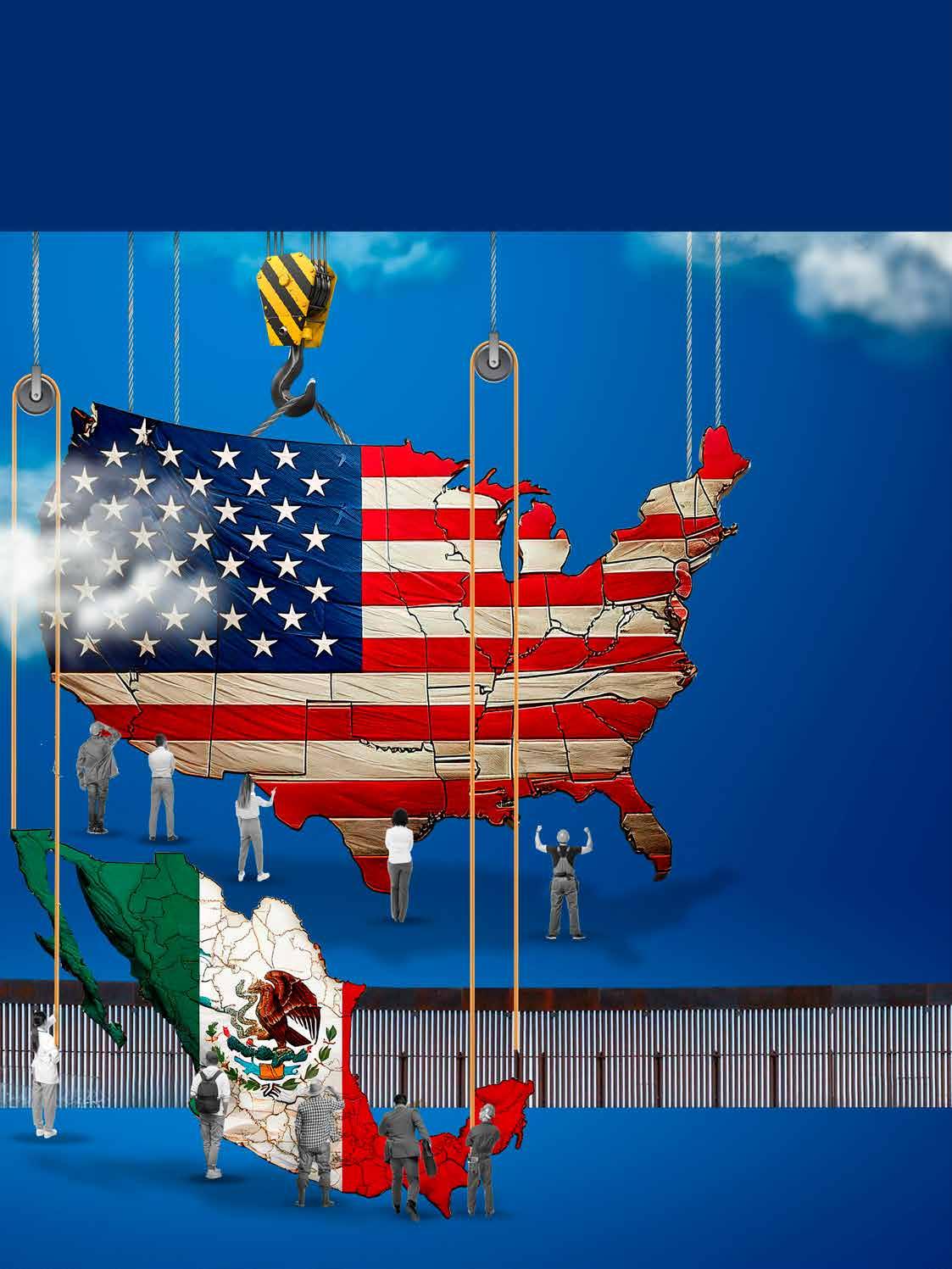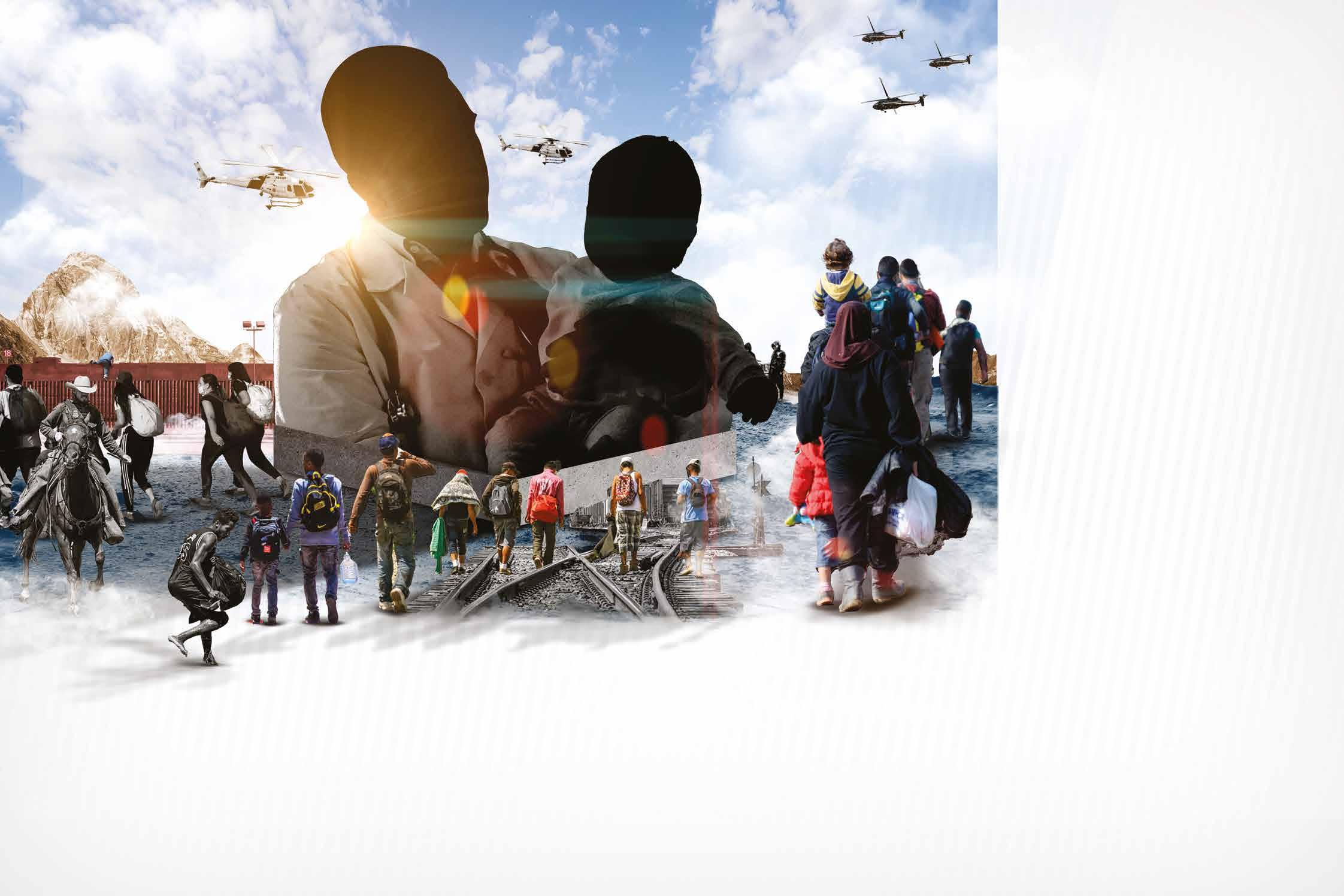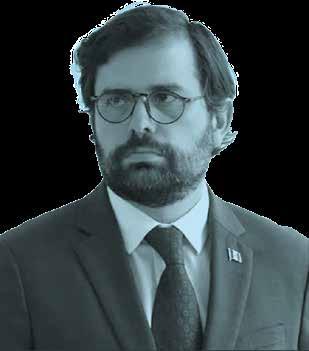
HOPE LIES WITH THE MILLIONS OF MIGRANTS IN BOTH COUNTRIES

Alejandro Svarch
X:@ALEXSVARCH



HOPE LIES WITH THE MILLIONS OF MIGRANTS IN BOTH COUNTRIES

Alejandro Svarch
X:@ALEXSVARCH

HEALTH EXISTS IN A PECULIAR PARADOX, AKIN TO A SONG THAT PLAYS ENDLESSLY, SO CONSTANT THAT WE OFTEN OVERLOOK IT—BARELY NOTICING IT, FAILING TO APPRECIATE ITS PRESENCE UNTIL IT ABRUPTLY FADES AWAY. IN THAT EMPTINESS, WE BECOME ACUTELY AWARE OF ITS SIGNIFICANCE AND VITALITY.
merous insights about life, notably that the harshest form of equal opportunity exists on the hospital gurney. This experience reveals the most fundamental and timeless truths of existence. At times, a gurney becomes a pool of blood where life fades; other times, it transforms into a melody from a distant place, filled with indistinct words, yet resonating with laughter like rhythmic drumbeats. This reminds me of my meeting with Juan, a boy, at the mobile hospital in Tijuana.
He arrived severely dehydrated, with sunken eyes, a vacant stare, a swollen belly from days without food, and a coughing fit that rattled his chest like a battlefield full of prisoners. He was in grave condition—extremely grave. We hydrated him immediately and headed for the operating room. Three hours later, he was asleep in the recovery ward. We did everything we could as caregivers. Patients, too, have their struggles—more invisible but just as intense. He survived the night.
When I checked on him at six in the morning, his aunt—or who claimed to be his aunt—was already there, sitting on the empty bed next to him. She was hunched over, singing softly, almost timidly, as if to herself. She sang a song from her beautiful homeland in a low voice, grateful that Juan was still alive. It moved me deeply; time seemed to stop as I listened and felt the weight of the moment.
Who is responsible for ensuring these nomadic individuals, these specters in the realm of political states, have their rights to health and life safeguarded?
While medicine must cautiously balance the best and worst outcomes, she believed Juan would make it, thanks to the faint sparkle in his smile. I couldn’t assure her; there were too many variables to evaluate. Yet, it didn’t take long for me to feel the same. As I left the mobile hospital and unbuttoned the first button of my lab coat, I felt confident that Juan would recover. His aunt resumed her gentle, soothing song. I left without saying goodbye, confident I would return to check on Juan. As I stepped away, her voice—a healing balm— provided solace to the child’s spirit, perhaps more effectively than any medication I could offer. I walked past numerous beds filled with patients and doctors. One patient caught my eye; he had been there for three days with a nasal tube, seemingly alone without any visitors or family. His eyes flickered open and closed, fixed on the makeshift fabric ceiling. His family had tried to cross the border, yet we had no information about them. I could envision him attuning to his aunt’s melody, riding its waves and yearning for the best possible outcome for his loved ones who risked everything to cross the border.
I departed from the mobile hospital with her song still resonating in my ears, bringing me comfort.
hat is when the rhythm of our lives—our habits, dance classes, flavors of food, and evenings spent with friends— turns into discordant sounds and awkward improvisations. In our suffering, feeling swollen and twisted, coughing uncontrollably, we make choices in a haphazard manner, within the same routines we fervently wish to reclaim. Many individuals in our world are trapped in lives lacking routine, existing in a reality where they are indifferent to their neighbors’ welfare. They move about. Millions are distanced from stable lives, stripped of the comforts of routine and community. The forces shaping their countries are of-
ten out of their reach, leaving their personal lives misaligned with the broader vision of societal welfare.
Who is responsible for ensuring these nomadic individuals, these specters in the realm of political states, have their rights to health and life safeguarded?
We took the initiative. Faced with the humanitarian crisis, we transitioned from a detached, analytical approach to one rooted in practical experience, compassion, and dedication to medical solidarity we transitioned from a detached, analytical approach to one rooted in practical experience, compassion, and dedication to medical solidarity. These factors were crucial in saving lives and led to the establishment of a mobile hospital.
As a field doctor, I’ve gained nu-
As the day progressed, Juan’s fever escalated dangerously to 40.9 °C, but eventually diminished. His physical condition remained unstable yet manageable. Neurologically, he was stable, calm, and experiencing some minor pain. Upon waking, he recognized his aunt and started to communicate. He displayed little emotion—his fight for survival the previous night had exhausted him completely. However, within that fragility, a glimmer of hope emerged. He smiled, and with that, he made it through the day. Gradually, he began to heal, and his aunt was always by his side. He prevailed. I explained the convalescence formalities to Juan’s aunt. I informed her that Juan remained in critical condition and that patience was necessary. She expressed her gratitude, relieved that Juan was still alive, as his survival represented hope—a hope to battle death, to overcome illness, and eventually to smile, even if just a little. This is where those who have suffered surpass medical knowledge.
As I unfastened the first button of my coat, I encountered the joyful laughter of children playing and leaping over a fence that separated the garden from the sidewalk. Their laughter lingers in my mind. Life is as simple as children playing a game and leaping over fences. If only that resulted in minor scrapes and no child ever found themselves in a hospital bed. But that isn’t the reality we face. At a very young age, Juan understood that life is conflict, and it’s within conflict that one feels most alive. Even so, I hope he spends a little more time joyfully jumping fences, innocent and still a child, unaware of the world of hierarchies awaiting him, still unable to grasp the civilization of a planet that tears apart childhoods and separates families. At the very least, I hope Juan and his aunt remain in my memory, singing and fighting for health on that gurney, even as the years and the earth pass over me.
Just two days after Juan arrived at the mobile hospital, barely clinging to life, I heard him laugh while playing with his friends. Still, a part of me—the part that sings—knew he would pull through.
In 2015, Mexico started a process of demystifying and partially legalizing marijuana use after the Supreme Court of Justice of the Nation (SCJN) issued a ruling. The Mexican legal framework has evolved to address changing realities. This dialogue includes efforts to ensure public and individual health while gradually decriminalizing and regulating various marijuana-related activities, such as cultivation, harvesting, and commercialization. Despite these advancements, comprehensive regulation of the issue is still pending on the national agenda.
BY SUSANA MERCADO ALVARADO*
Mdeclared that the total ban on recreational ma rijuana use outlined in the General Health Law was unconstitutional, as it unfairly limited the right to personal development. This decision permitted the individual involved to grow and use marijuana for personal purposes without any commercial intent.
Similar until 2021 when the Supreme Court broadened its ruling to have widespread implications. It lifted the complete ban on recreational marijua na use under the General Health Law, enabling health authorities to permit activities concerning the self-consumption of cannabis and tetra hydrocannabinol (THC) for adults if they were non-commercial.


AFTER A FIVE-YEAR HIATUS
FROM NEW MUSIC, THE MEXICAN BAND PANTEÓN ROCOCÓ RETURNS TO THE STUDIO WITH AN EXCITING ALBUM THAT AIMS TO REFLECT THEIR MOST PLAYFUL AND LIBERATED SPIRIT.
BY NAYELLI RAMÍREZ
JORGE PEÑALOZA
As they approach their 30th anniversary, their lead single, “Rojo,” serves as a declaration of their intentions, blending freshness, nostalgia, and melodies that
Panteón Rococó’s 30-year journey is more than a milestone; it’s a celebration they aim to honor with new music. Staying true to their democratic approach, the band made this decision together. “We operate like an assembly. Ideas are voted on, and we chose to celebrate our 30th anniversary with a new album,” Felipe explains.
The celebration has begun, and with Rojo’s release, the band is gearing up for what looks like an exciting 2025 filled with parties and tours. “This song means a lot to us because we have spent more time with Panteón than without it,” Felipe expresses proudly.
connect generations.
“This album returns us to the band’s essence,” says Felipe Bustamante, the keyboardist for Panteón. “After years of a demanding schedule, we needed to produce new music and savor the experience. Rojo represents the freedom we embrace to blend rock, reggae, ska, and even hardcore. It embodies the liberated Panteón, the one that revels in its identity and remains linked to its origins.”
The band, celebrated for pushing musical limits, delivers a track featuring dynamic guitars and an infectious beat. More than just its contemporary sound, the song explores themes of love and madness—universal emotions that stand the test of time. Dr. Shenka, the lead vocalist, enriches Rojo with a nostalgic flavor while maintaining a modern perspective.
Panteón Rococó has managed to harmonize professional achievements with personal responsibilities over the course of their careers. Felipe recounts a story that exemplifies this equilibrium:
“While recording, had to travel to Germany for a commitment with my daughters, which prevented me from joining the band in Los Angeles. However, sent my sessions over; the producer selected what he liked, and the process went smoothly. It felt more liberating since we understand that family commitments deserve our focus as well.”
Panteón Rococó has never let itself be pigeonholed. While often associated with ska, their music constantly blends styles. Felipe explains:
“We come from a generation where rock had a certain status, and there were musical prejudices. But we’ve always been an open band, free to mix genres. If we want to do a cumbia, we do it. If we feel like switching to hardcore, we go for it. We’ve never felt like just a ska band; we feel comfortable blending any music.”
This genre fusion defines their identity and has been key to staying relevant and connecting with diverse audiences.
Panteón Rococó is the band with the highest number of performances at Vive Latino, a major music festival in Latin America. For Felipe, this event is particularly significant:
“Our first performance was in 2000. As a relatively new band with only a demo, we were scheduled to play on the smaller stage, the Curva. We felt extremely nervous. However, as the audience began to gather, it became an amazing experience. Each time we come back to Vive Latino, it floods us with memories.”
In 2024, Panteón Rococó solidified its status as a favorite band at the festival, demonstrating that its energy remains vibrant.
diverse battle—a fight for the rights of all, for dignified and efficient care, and for a new perspective and narrative that recognizes the immense contributions and achievements resulting from their strength, tenacity and drive.
BY: ANGÉLICA SIMÓN UGALDE / DESIGN: ALEJANDRO OYERVIDES











